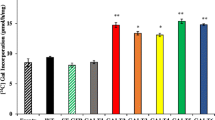Abstract
Arabinogalactan-proteins (AGPs) are a family of highly glycosylated hydroxyproline-rich glycoproteins (HRGPs). AtAGP17, 18 and 19 comprise the lysine-rich classical AGP subfamily in Arabidopsis. Overexpression of GFP–AtAGP17/18/19 fusion proteins in Arabidopsis revealed localization of the fusion proteins on the plant cell surface of different organs. Subcellular localization of the fusion proteins at the plasma membrane was further determined by plasmolysis of leaf trichome cells. To elucidate AtAGP17/18/19 function(s), these AGPs were expressed without the green fluorescent protein (GFP) tag under the control of 35S cauliflower mosaic virus promoter. In contrast to AtAGP17/AtAGP19 overexpressors which showed phenotypes identical to wild-type plants, AtAGP18 overexpressors displayed several phenotypes distinct from wild-type plants. Specifically, these overexpressors had smaller rosettes and shorter stems and roots, produced more branches and had less viable seeds. Moreover, these AtAGP18 overexpressors exhibited similar phenotypes to tomato LeAGP-1 overexpressors, suggesting these two AGP genes may have similar function(s) in Arabidopsis and tomato.





Similar content being viewed by others
Abbreviations
- ABA:
-
Abscisic acid
- AGP:
-
Arabinogalactan-protein
- CaMV:
-
Cauliflower mosaic virus
- GFP:
-
Green fluorescent protein
- GPI:
-
Glycosylphosphatidylinositol
- GUS:
-
β-Glucuronidase
- MS:
-
Murashige and Skoog
References
Acosta-Garcia G, Vielle-Calzada JP (2004) A classical arabinogalactan protein is essential for the initiation of female gametogenesis in Arabidopsis. Plant Cell 16:2614–2628
Borner GH, Sherrier DJ, Weimar T, Michaelson LV, Hawkins ND, Macaskill A et al (2005) Analysis of detergent-resistant membranes in Arabidopsis. Evidence for plasma membrane lipid rafts. Plant Physiol 137:104–116
Clough SJ, Bent AF (1998) Floral dip: a simplified method for Agrobacterium-mediated transformation of Arabidopsis thaliana. Plant J 16:735–743
Fincher G, Stone B, Clarke A (1983) Arabinogalactan-proteins: structure, biosynthesis, and function. Annu Rev Plant Physiol 34:47–70
Gaspar YM, Nam J, Schultz CJ, Lee LY, Gilson PR, Gelvin SB et al (2004) Characterization of the Arabidopsis lysine-rich arabinogalactan-protein AtAGP17 mutant (rat1) that results in a decreased efficiency of Agrobacterium transformation. Plant Physiol 135:2162–2171
Gens JS, Fujiki M, Pickard BG (2000) Arabinogalactan protein and wall-associated kinase in a plasmalemmal reticulum with specialized vertices. Protoplasma 212:115–134
Johnson KL, Ingram GC (2005) Sending the right signals: regulating receptor kinase activity. Curr Opin Plant Biol 8:648–656
Li S, Showalter AM (1996) Cloning and developmental/stress-regulated expression of a gene encoding a tomato arabinogalactan protein. Plant Mol Biol 32:641–652
Li Y, Hagen G, Guilfoyle T (1992) Altered morphology in transgenic tobacco plants that overproduce cytokinins in specific tissues and organs. Dev Biol 153:386–395
Nothnagel EA (1997) Proteoglycans and related components in plant cells. Int Rev Cytol 174:195–291
Schultz CJ, Rumsewicz MP, Johnson KL, Jones BJ, GasparYM BacicA (2002) Using genomic resources to guide research directions. The arabinogalactan protein gene family as a test case. Plant Physiol 129:1448–1463
Seifert GJ, Roberts K (2007) The biology of arabinogalactan proteins. Annu Rev Plant Biol 58:137–161
Sherrier DJ, Prime TA, Dupree P (1999) Glycosylphosphatidylinositol-anchored cell-surface proteins from Arabidopsis. Electrophoresis 20:2027–2035
Showalter AM (2001) Arabinogalactan-proteins: structure, expression, and function. Cell Mol Life Sci 58:1399–1417
Showalter AM, Keppler B, Lichtenberg J, Gu D, Welch LR (2010) A bioinformatics approach to the identification, classification, and analysis of hydroxyproline-rich glycoproteins. Plant Physiol 153:485–513
Sun W, Kieliszewski MJ, Showalter AM (2004a) Overexpression of tomato LeAGP-1 arabinogalactan-protein promotes lateral branching and hampers reproductive development. Plant J 40:870–881
Sun W, Zhao ZD, Hare MC, Kieliszewski MJ, Showalter AM (2004b) Tomato LeAGP-1 is a plasma membrane-bound, glycosylphosphatidylinositol-anchored arabinogalactan-protein. Physiol Plant 120:319–327
Sun W, Xu J, Yang J, Kieliszewski MJ, Showalter AM (2005) The lysine-rich arabinogalactan-protein subfamily in Arabidopsis: gene expression, glycoprotein purification and biochemical characterization. Plant Cell Physiol 46:975–984
Svetek J, Yadav MP, Nothnagel EA (1999) Presence of a glycosylphosphatidylinositol lipid anchor on rose arabinogalactan proteins. J Biol Chem 274:14724–14733
Weigel D, Glazebrook J (2002) Arabidopsis: a laboratory manual. Cold Spring Harbor, New York
Yang J (2006) Functional identification of three lysine-rich arabinogalactan-proteins (AGPs) in Arabidopsis. Dissertation, Ohio University
Yang J, Showalter AM (2007) Expression and localization of AtAGP18, a lysine-rich arabinogalactan-protein in Arabidopsis. Planta 226:169–179
Yang J, Sardar HS, McGovern KR, Zhang Y, Showalter AM (2007) A lysine-rich arabinogalactan protein in Arabidopsis is essential for plant growth and development, including cell division and expansion. Plant J 49:629–640
Yang J, Zhang Y, Liang Y, Showalter AM (2010) Expression analyses of AtAGP17 and AtAGP19, two lysine-rich arabinogalactan-proteins, in Arabidopsis. Plant Biol. doi:10.1111/j.1438-8677.2010.00407.x
Youl JJ, Bacic A, Oxley D (1998) Arabinogalactan-proteins from Nicotiana alata and Pyrus communis contain glycosylphosphatidylinositol membrane anchors. Proc Natl Acad Sci USA 95:7921–7926
Acknowledgments
We are particularly grateful to Dr. Li Tan in the Department of Chemistry and Biochemistry at Ohio University for providing the pUC-ss-GFP construct. This work was supported by the National Science Foundation [IBN-0110413].
Author information
Authors and Affiliations
Corresponding author
Electronic supplementary material
Below is the link to the electronic supplementary material.
Rights and permissions
About this article
Cite this article
Zhang, Y., Yang, J. & Showalter, A.M. AtAGP18 is localized at the plasma membrane and functions in plant growth and development. Planta 233, 675–683 (2011). https://doi.org/10.1007/s00425-010-1331-6
Received:
Accepted:
Published:
Issue Date:
DOI: https://doi.org/10.1007/s00425-010-1331-6




